

| Invertebrate news 2023 |
| Insect and Arachnid related news from around Nottinghamshire |
| Want your interesting or notable Nottinghamshire sightings listed? email trevorpendleton63@gmail.com |
| Glow Worms and other
invertebrates under threat again at Clipstone Old Quarter as mowing
undertaken On the evening of June 1st, I visited Clipstone Old Quarter to survey for Glow Worms after recording four glowing females the previous evening during a visit to the site. However, this visit wasn't to end well and if I'm being honest, I might not be back to record Glow Worms there again. As I rounded the Centre Tree to make my way down the grass strip sections of D, C, B and A, I was shocked to see that either side of the Sustrans path/cycle route, had been flail mowed using a tractor-pulled unit. Interest in recording any other Glow Worms was quickly gone, as I realised that the mowing continued, ultimately finding that up to 6-8ft either side of the shale path had been flailed. The worst affected side was the eastern-side of the path, where all growing vegetation had been cut to ground level in places and up to the Hollys along the length of the four survey sections. This action also took out developing nectar-bearing flowers (the best section here for flora) scrub, bramble and Honeysuckle known to have had eggs of the Broad-bordered Hawk-moth on and which of course are now lost. |
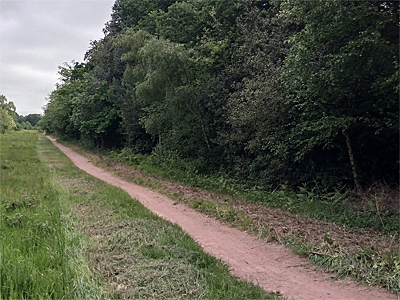 |
|
|
Once again, a site within the Sherwood Forest NNR and part
of one of the two SSSI's making up that NNR, has suffered at the
hands of wildly indescriminate, disgraceful management practice.
I immediately sent a text to Forestry England, who replied promptly first thing the next morning, saying they had no idea who was responsible. An email was sent to the Sherwood Forest Trust, who came back with the reply that it was 'very odd and disappointing', but they knew nothing of any proposed work. But this has never happened before, at least nothing else other than the annual cut the grass strip used to get each year until around five or six years ago. But that was always done at the correct time of year to cause minimal disturbance to the site's Glow Worms and other wildlife, between September and March each year and not late May/early June. I returned to Clipstone Old Quarter early the next morning and noted that the mowing continued (or originated from) the Sustrans path running north from the Centre Tree towards the RSPB's reserve at Budby South Forest at it's junction with the Sherwood Forest CP. A later walk to Budby South Forest from Budby Pumping Station, showed that the northerly access track around the reserve had also been cut similarly. |
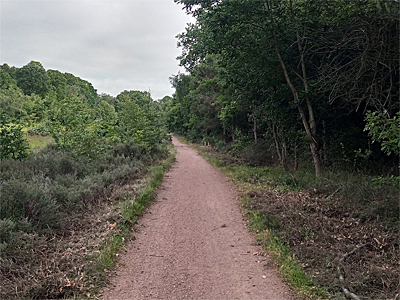 |
|
| I am intent on finding out who's responsible for this mowing and will be reporting it to Natural England. Once again, it goes to prove that some managers, or their workers cannot be trusted and that there is no respect or consideration given towards wildlife here. I suspect that maybe this will be a case of 'friends covering up for friends' and we'll never find out who is responsible. But I have a very good idea of who's done this. | ||
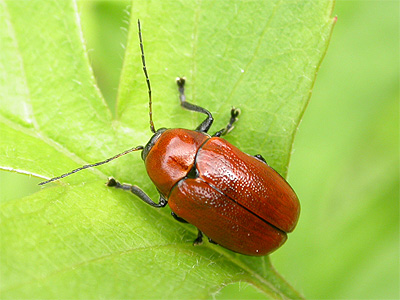 |
The Hazel Pot Beetle Cryptocephalus coryli at Clumber Nick and Samantha Brownley continue to record a number of rare Nottinghamshire invertebrates and recently added a RDB1 (Red Data Book 1) species to their growing list, with a record of the Hazel Pot Beetle Cryptocephalus coryli (Linnaeus 1758) from Clumber Park.The find, of a female near the Applyhead Lodge entrance on May 13th, is thought to be the second record for Clumber Park, after Allan and Annette Binding found the first Cryptocephalus coryli for Clumber back in 2014. The pair also provided a second county record and site of another leaf beetle, this time the Broom Leaf Beetle Gonioctena olivacea (Forster, 1771), with a number of adults found, while the same area turned up another rare county beetle, this time the Violet Weevil Orobitis cyaneus (Linnaeus, 1758), with a pair found at the base of Violets in the grass verges at the Applyhead Lodge entrance on May 16th (Pendleton, T.A.). |
|
|
Rhombic Leatherbug at Sherwood Forest It's always nice to recieve emails, but more so when they contain exciting news. Such an email arrived on May 8th, detailing the record of a Rhombic Leatherbug Syromastus rhombeus (Linnaeus, 1767) close to the cricket pitch at Edwinstowe.The find was made by Thomas Hibbert on April 30th and seems to be a first record for Nottinghamshire. The NBN Atlas lists Rhombic Leatherbug records to as far north as the Peterborough area and so it should not really be surprising that it has turned up here. But its UK distribution is predominantly south-easterly and in some coastal areas across the south to Wales. There seem to be no records from the neighbouring counties of Derbyshire, Lincolnshire or Leicestershire, but this looks to be another bug expanding its UK range north. |
||
|
A new Flatworm for VC56 Nottinghamshire Adrian Dutton reports the finding of the flatworm Microplana terrestris (Müller OF, 1773) and which is believed to be new to Nottinghamshire.Microplana terrestris is a dark brown coloured species, which was found by Adrian inside a rotten log on Budby South Forest in early May 2023. Records of any flatworm in Nottinghamshire are still extremely few, with most of the eight known county species being reported on just one or two occasions. All are modern records, such has been the lack of interest showed in both our native and non-native flatworm fauna, but records are finally making it onto the NBN Atlas. |
||
|
A surprise second county record and site of the spider Araniella displicata (Araneidae) Nick and Samantha Brownley continue to be rewarded for their dedication in recording an increasing range of invertebrates from around Nottinghamshire. The former Calverton Colliery is one of their regular haunts away from Sherwood Forest and regularly turns up rare and scare species.But the finding of a mature female Araniella displicata (Hentz, 1847) there in April 2023, must certainly be the best record the former colliery site has produced so far. Araniella displicata was only recorded new to Nottinghamshire in October 2020, when a large (but still immature) female was found in its small orb-web on a mature Yew Taxus baccata growing at St Mary's Church, Edwinstowe. In view of the rarity of the record and that it was well away from its southerly range in the UK, it was retained and kept in captivity over the Winter. After moulting through to adult was released back on site in the Spring of 2021. |
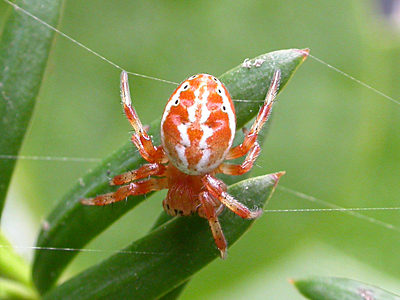 |
|
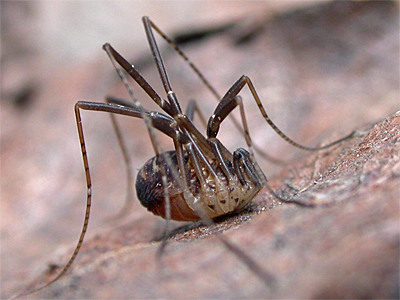 |
Three years after first arriving in the UK, Dicranopalpus larvatus makes it to in Nottinghamshire The speed at which some invertebrates arrive, colonise and extend their range through the UK, is very often surprising. Yet another harvestman seems to have made it to Nottinghamshire in record time. Only three years ago, the UK saw its first record of Dicranopalpus larvatus (Canestrini, 1874) and although always on the lookout to add another harvestman to the county's fauna, never expected to be so fortunate so soon. On April 9th 2023, I paid a visit to Woodthorpe Park, in particular an area near the former walled garden/plant nursery. My intention was to check on numbers of the Flatworm Australopacifica atrata, which I never found. But on turning over a small piece of rotten log lying on the ground, I was surprised to find a harvestman underneath. I could make out the colouration of the upper surface of both head and body and straight away, saw the darker (mask-like) area around the eyes. A |
|
| A few quick photographs confirmed my suspicion that this was indeed a female Dicranopalpus larvatus and that it was new to Nottinghamshire. The stance of D.larvatus was interesting as it reminded me of some Linyphid spiders which sometimes adopt a similar stance, as they are just as leggy. However, when completely settled, the legs are more splayed outwards, but nothing like the resting position of the more familiar Dicranopalpus ramosus. The discovery takes the number of harvestman species currently known from Nottinghamshire to 23. | ||
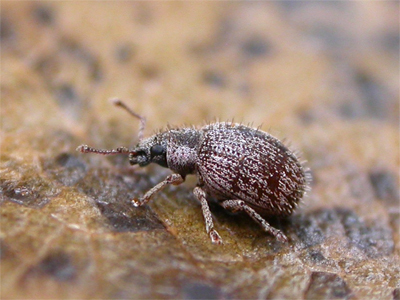 |
An almost 200 year wait for Nottinghamshire's second record of the weevil Brachysomus echinatus There can't be many longer waits for a county's second record of a species, than the 195 years it had been since an insignificant looking weevil turned up while sorting through a carrier bag of leaf wood chippings.The last handfuls of the sample, taken from underneath some old Beech trees at Cuckney, proved to contain the weevil Brachsomus echinatus (Bonsdorff, 1785) and is the first Nottinghamshire record, which was quickly confirmed by the county recorder. The county's only other record being from Clumber Park in 1828. Another rare, or at least rarely recorded weevil, which also turned up at the same site just a day later was Acalles misellus (Boheman, 1844). There are recent county records from the Proteus Square and Buck Gates areas of the Sherwood Forest NNR (Denton, M.L. et al) in 2002 and from Clarborough Tunnel NR (Kirby, P.) in the north-east of the county, also in 2002. |
|
|
Coleoptera recorded new to Sherwood Forest in 2022 Adrian Dutton, the Nottinghamshire county recorder for coleoptera, has passed on a list of three new species of beetle recorded from the Sherwood Forest area in 2022, also noting the rediscovery of one other species after many years 'missing'.Recorded new last year were Aderus populneus (Creutzer, 1796), Lithostygnus serripennis (Broun, 1914) which is a beetle thought to be of Australasian origin, Cryptophilus propinquus (Reitter, 1874) and Prionocyphon serricornis (Redtenbacher, 1858) the latter recorded for the first time at Sherwood Forest since 1904 (all Dutton, A.). It Is interesting to note that Adrian's record of Aderus populneus, was also a new record for Nottinghamshire and a surprisingly quick second record has recently come from Cuckney in March 2023 (Pendleton, T.A.), when two specimens were found in a leaf litter sample taken from the base of several over-mature Beech trees. It seems likely that rather than just being coincidence (in view of the number of surveys condicted at Sherwood over the years, that Aderus populneus is a recent arrival into Nottinghamshire. |
||
|
Some recent False Scorpion records Inclement wintry weather often curtails invertebrate recording for many, but 'sampling' different mediums such as dry manure, grass cuttings, leaf litter etc, or looking under loose bark, can help pass many a cold wet evening.Sorting through such samples in the waarmth and comfort of your own home, also provides the local biological records centre with some much needed records of those less recorded invertebrate orders such as False Scorpions (pseudoscorpions). Work over the early months of 2023 have provided the following records. Chernes cimicoides - recorded under bark from Blackpool Plantation March 16th, Kirton Wood March 18th (Brownley, N. and Brownley, S.) and Clipstone Old Quarter March 24th. Lamprochernes chyzeri (illustrated right) - recorded under bark at Clipstone Old Quarter February 12th and Pselaphochernes scorpioides - from dry grass cuttings at Cuckney Church March 5th. |
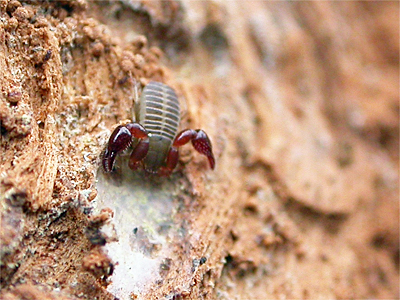 |
|
|
Hummingbird Hawk-moths in Nottinghamshire already There's already been two early reports of Hummingbird Hawk-moth Macroglossum stellatarum (Linnaeus, 1758) with singles recorded from gardens at Wellow March 18th (Burrows, D.) and Stanton-on-the-Wolds March 22nd (Mather, S.).Early records of Hummingbird Hawk-moth in Nottinghamshire are not unknown and a quick look back through the records published the county recorder's 'macro moth reviews of the year ' (Wright, S.) shows that the moth has only just started to overwinter in the county, with recent early Spring records coming from Mansfield Woodhouse on March 4th 2020 (Bradbury, C.) and Misterton on March 31st 2021 (Lee, P.) |
||
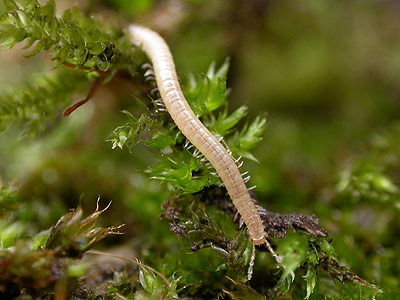 |
Finally - follow up records of two rare Nottinghamshire millipedes It's taken a few years, but two rare/scarce or just plain under-recorded millipedes, have been recorded again from a suburban Mapperley garden.The site has produced a number of (currently) rare Nottinghamshire millipedes over the past few years, including at least two county firsts in Melogona scutellaris (Ribaut, 1913) and Leptoiulus belgicus (Latzel, 1844) while also confirming Brachychaeteuma bagnalli (Verhoeff, 1911) as a Nottinghamshire species. And it is pleasing to note that there have been recent records of Brachychaeteuma bagnalli on March 5th 2023 and Melogona scutellaris on March 23rd 2023. Both species are typically found underneath bricks or rockery stone, sat on soil. |
|
|
Nottinghamshire VC56 micro moth report 2022 by Martin Gray A great mothing year especially with the arrival of migrant species and caneasily compare with 2006 with more rarities recorded this year. The likes of Udea ferrugalis Rusty Dot Pearl, Nomophila noctuella Rush Veneer and Plutella xylostella Diamond-backed Moth, were recorded on a regular basis. The former rare micro moths Scrobipalpa ocellatella Beet Moth and Loxostege sticticalis were also recorded in good numbers throughout the county. The hot spell during the year may have an effect this year as many pupae and larva would most likely have succumbed to such high temperatures. To date I have collated over 20,000 records which is more than I anticipated with more to come, I am sure. To date in 2022 Nottinghamshire has recorded 9 additions to the county list. The moths highlighted below depict new species recorded in recent years to Nottinghamshire VC56. |
||
| ... | ||
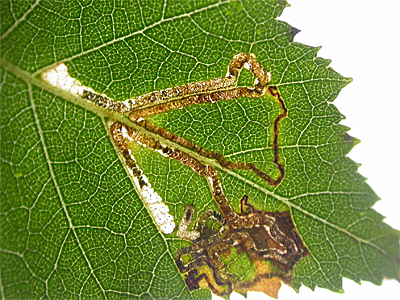 |
4.006 (113) Stigmella
sakhalinella (Puplesis, 1984) - Most records of this
species are from leaf mines found on Birch leaves. Trevor Pendleton
found Nottinghamshire’s first record at Warsop Main Pit Top in
October 2022. Quite a common species and surely more records to come
in the future. 4.082 (25) Ectoedemia intimella (Zeller, 1848) - New to Nottinghamshire in late October, when two occupied leaf mines were found by Trevor Pendleton on Goat Sallow Salix caprea, at Warsop Main Pit Top. Easy to look for in late Autumn on fallen leaves especially and again quite a common species. 12.023 (226) Triaxomasia caprimulgella (Stainton, 1851) - A very rare, proposed Red Data Book species in Britain. With the recent introduction and widespread use of pheromone lures, males have been found to be attracted to the Hornet Moth Lunar Hornet Moth lures. Roger Freestone recorded the first Nottinghamshire record to the LUN (Lunar Hornet Moth) lure in West Bridgeford in July 2022. More records to come with the use of the lure I suggest. |
|
| ... | ||
| 15.012 (290)
Caloptilia semifasciella (Haworth, 1828) - Recorded
new to the county as recently as August, when an individual was
attracted to light at Keyworth by Neil Pinder. It is now regarded
that all Acer feeding Caloptilia species require dissection to
separate yellow banded summer broods. 15.060 (339) Phyllonorycter ulicicolella (Stainton, 1851) – Recorded from several sites by Trevor Pendleton on 24 September 2022, a new species for Nottinghamshire. Recorded usually as larva that feed in the epidermis of thinner stems of Gorse Ulex and causes slight blistering. The mines are quite easy to spot within the stems being a lighter colour once you have your eye in. The adults are rarely seen. Must be much more common than records suggest. |
||
| ... | ||
| 15.087 (365)
Phyllonorycter comparella (Duponchel, [1843]) – A
great find by Trevor Pendleton again by spotting the mines of this
species on Grey Poplar Populus x canescens, growing at
Ollerton Pit Woods and breeding one through to an adult. This is
another leaf miner moving up the country which also uses White &
Black Poplar species as well. Hopefully should be recorded more
frequently in the future. 16.008 (431) Yponomeuta sedella Treitschke, 1832 - One of the more distinctive Yponomeuta, distinguished by the grey head, pale grey wing and lack of dots in the terminal area. Most likely to be confused with darker individuals of Y.padella. Steve Mathers trapped Nottinghamshire’s first record back in April 2022. The larva feeds on Orpine Sedum telephium, living gregariously within a silken web, over-wintering as a pupa. 32.042 (676) Depressaria pulcherrimella - Distributed locally throughout much of the British Isles, this species has a pale buff head and thorax and a fairly rich mixture of chestnut, black and white on the forewings. Martin Gray attracted one to light in Broadholme in July 2022 a first for the county. |
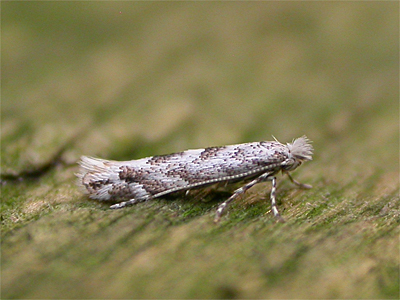 |
|
| ... | ||
| Although well
distributed, some of the early life stages are still undescribed,
but the later instar larvae feed on Wild Carrot Daucus carota,
Pignut Conopodium majus and Burnet-saxifrage Pimpinella
saxifraga. 41.0040 (873a) Blastobasis vittata (Wollaston, 1858) - The first British record was recorded at Lindfield, West Sussex as recent as 2008 and now appears to be working its way up the country. Nottinghamshire’s first record was back in November 2020 in Roger Freestone's garden, who recorded it again the following year. A double brooded species found in all but the coldest months of the year. |
||
| ... | ||
| This is a very
variable species of Blastobasis and can only be confirmed
by dissection. One to look out for in the future, generally much
smaller than the commoner Blastobasis species. 49.278 (1171) Scrobipalpa occellatella Beet Moth (Boyd, 1858) – Not recorded in Nottinghamshire until this year following a large eruption in Britain including to many inland sites. Now thought that cultivated forms of Beta vulgaris (Sugar-beet) may be included as a foodplant, much to farmers annoyance I am sure. The first record appears to be shared on 15 August 2022 by Martin Gray from his Broadholme garden and Chris Cooper from his Upper Saxondale garden. 62.047 (1461) Assara terebrella (Zincken, 1818) - This pyralid moth is a Nationally Scarce A species. A rather rare and local species, occurring in Spruce plantations mainly in the south of England and East Anglia. The larvae feed inside the cones of Norway spruce Picea abies, causing them to become distorted and stunted. Ian Ellis recorded Nottinghamshire’s first record at Bramcote back in July 2021, with further records since. One to look out for in the future. |
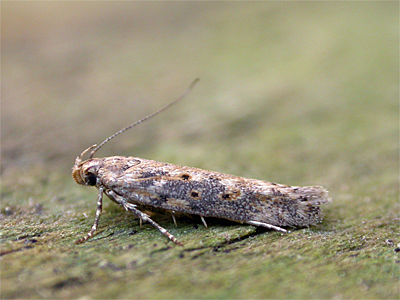 |
|
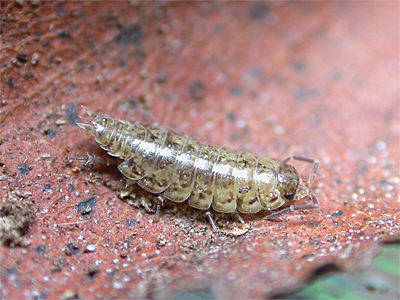 |
The woodlouse Philoscia affinis recorded from the Sherwood Forest NNR A leaf litter sample collected from at site within the Sherwood Forest CP, finally provided Nottinghamshire with a second site for the rare woodlouse Philoscia affinis (Verhoeff, 1908) a species so far showing a westerly bias across the UK. Prior to the Sherwood Forest find,
Philoscia affinis was only known
from an area of woodland alongside the River Meden at Meden Vale,
where it was found on two occassions in 2020 after several years of
searching. |
| Insects |
| Homepage |
| Contents |